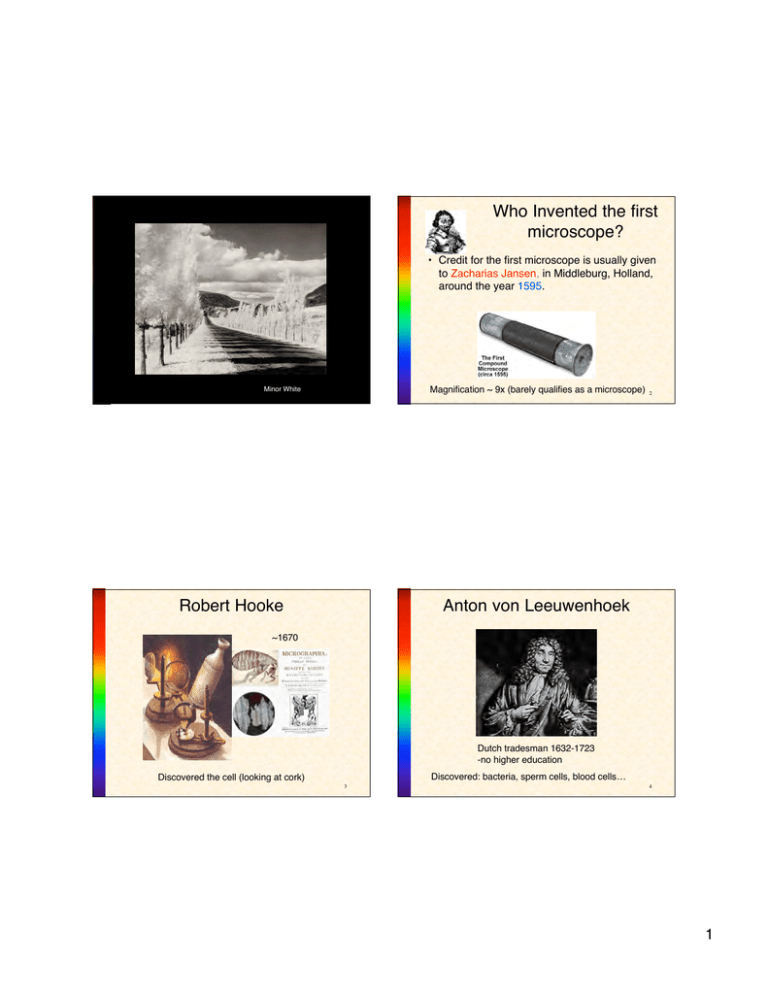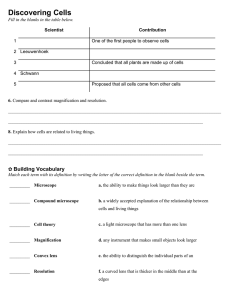Who Invented the first microscope? Robert Hooke Anton von
advertisement

Who Invented the first microscope? • Credit for the first microscope is usually given to Zacharias Jansen, in Middleburg, Holland, around the year 1595. Minor White 1 Robert Hooke Magnification ~ 9x (barely qualifies as a microscope) 2 Anton von Leeuwenhoek ~1670 Dutch tradesman 1632-1723 -no higher education Discovered: bacteria, sperm cells, blood cells… Discovered the cell (looking at cork) 3 4 1 Anton von Leeuwenhoek Anton von Leeuwenhoek • Single tiny lens an unbelievably great company of living animalcules, a-swimming more nimbly than any I had ever seen up to this time. The biggest sort. . . bent their body into curves in going forwards. . . Moreover, the other animalcules were in such enormous numbers, that all the water. . . seemed to be alive. "these little animals were, to my eye, more than ten thousand times smaller than the animalcule which Swammerdam has portrayed, and called by the name of Waterflea, or Water-louse, which you can see alive and moving in water with the bare eyes.” - letter to Royal Society 1678 Discovery of bacteria In the mouth of old man who had never brushed his teeth! Magnification ~ 270X Magnification ~ 270X 5 Compound Microscope 6 An example • Structure: Made of two lenses, Objective and eyepiece – Objective: The object being viewed is placed just outside the focal length of the objective lens. The intermediate image thus formed is real, inverted, and enlarged. • Suppose the focal length of the objective is 12mm, and the object is placed at 13mm. The image is then 156mm away from the lens and the magnification is 156/13 = 12 X 1/si = 1/f - 1/so 7 8 2 – Eyepiece: Work as a magnifying glass, used to view the real intermediate image formed by the objective lens. • To view the image with a relaxed eye (so the light rays entering the eye is parallel), the image must be located at the focal point of the eyepiece. • Shorter the focal length, larger the magnification. 9 Microscope eyepiece 10 Compound microscope Same principle as magnifying glass Total magnification = M obj X Meyepiece No lens = si/fobj X 250/f eyepiece Si = 160 mm for standard microscopes ~ 250 mm With lens Example - fobj = 1.6mm, feyepiece =25 mm f Magnification = 250/f (in mm) M = 100 X 10 = 1000 11 12 3 13 Oil immersion objective 14 Confocal microscopy - high magnification -> short focal length - big angles Oil with n = 1.5 15 16 4 Optical limitation • Light cannot be focused to less than ~ λ -due to diffraction (coming up later in course) Solutions - use short wavelength (e.g. x-rays) - use something other than light 17 neuron Fruit fly 18 Scanning Tunneling Microscope Electrical current depends sensitively on distance Cat flea Black ant 19 20 5 Scanning tunneling microscopy (STM) 21 6


